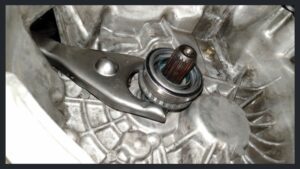
4 Symptoms of a Bad Release Bearing
In a manual transmission, the clutch links engine speed to wheel speed. Pressing the clutch pedal breaks the relationship between engine speed and wheel speed. If the release bearing breaks, problems will occur.
How the release bearing works
The clutch fork rotates with the movement of the clutch pedal, and the “forked” end presses the release bearing against the pressure plate.
The 4 Most Common Symptoms of a Defective Release Bearing
If your release bearing is bad, there are obvious symptoms that can appear. Below are the most common signs to look out for. If left unaddressed, they can become more noticeable over time.
1) Stiff or Sticking Clutch
For the release bearing to function smoothly, its lubricating properties must be maintained for as long as possible. As the bearing ages, so does the grease inside, which creates more heat due to metal-to-metal contact in the bearing. This causes the bearing to wear out over time.
When this happens, the bearing becomes stiff and the clutch becomes harder to disengage. This can make the vehicle very difficult to drive and may prevent the clutch from disengaging completely.
2) Difficult to shift
If your manual transmission vehicle is having difficulty shifting gears, it may be due to a failed release bearing. This symptom often occurs in the later stages of the previous symptom, a stuck clutch.
Continual inability to release the clutch increases the risk of the vehicle stalling. Stalling can be very dangerous, especially if you are in traffic and the stalled vehicle is an obstacle on the road.
If you are having problems shifting, you should also check other components to see if they need maintenance.
3) Abnormal noises
Release bearings have rollers and shouldn’t have much space between them. However, as the bearing wears out, there will be more play in this area. This will cause the bearing to wobble more and create abnormal noises.
You may hear groaning, rattling, and even squealing and whistling noises. All of these noises can originate from the gearbox area.
4) Vibrating Clutch Pedal
If you feel a vibration under your foot when you press the clutch pedal, it may be due to a faulty release bearing. Such vibrations are caused by the bearing not being able to connect evenly to the pressure plate, or by wear on the bearing itself, causing it to vibrate over time.
This creates a pulsating effect felt under your foot that travels through the pedal. This vibration may also be accompanied by an abnormal noise. If you notice such vibrations when accelerating or braking, you should also check other components such as brakes, wheel bearings, and axles.

